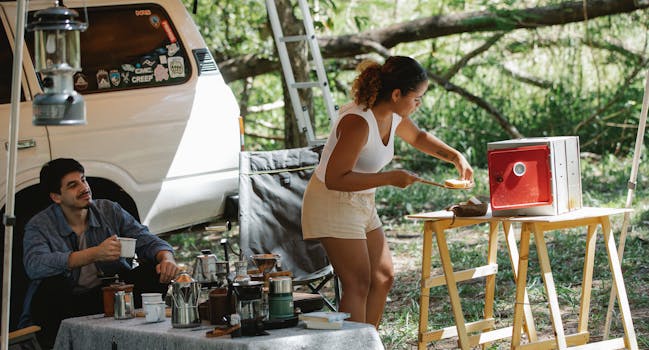Anúncios
Creating outdoor materials can be a rewarding and creative endeavor. Whether you’re looking to craft garden furniture, decorative items, or functional structures, there are numerous possibilities to explore.
This guide will walk you through the essential steps, materials, and best practices for creating outdoor items that are both durable and aesthetically pleasing. By the end, you’ll be ready to tackle your own outdoor projects with confidence.
From choosing the right materials to understanding the tools required, each section will provide you with the knowledge to make your outdoor creations a reality. Let’s dive in!
Understanding Outdoor Materials
Before embarking on any project, it’s crucial to understand the types of materials suitable for outdoor use. Various options provide different benefits and levels of durability.
Common materials include wood, metal, stone, and plastic. Each has unique properties that influence their longevity and appearance in outdoor settings.
Anúncios
Choosing the right material depends on the specific project’s requirements and environmental factors. Consider exposure to elements like rain, sun, or snow.
Wood provides a natural look and can be treated for longevity, while metal offers durability and modern aesthetic. Plastic is lightweight and resistant to fading.
Ultimately, your choice will impact not just the final product but also your maintenance routine. So, take your time to evaluate your options carefully.
Anúncios
Choosing the Right Tools
Having the correct tools can make all the difference in your outdoor material projects. Essential tools include saws, drills, and screws, depending on the material.
For wood projects, a miter saw or circular saw is essential for straight cuts. A hand saw can also be useful for smaller cuts and precision work.
Metalworking might require a different set of tools, including a grinder and welder. Ensure your tools are suited to the material you’re working with for smoother execution.
Measure and mark your materials accurately before cutting. This step often saves time and reduces waste, ensuring your pieces fit together as planned.
Lastly, don’t forget about safety gear like gloves, goggles, and masks when working with power tools or dust-generating materials.
Preparing Your Workspace
A well-organized workspace can significantly enhance the efficiency of your projects. Ensure you have ample space to move around freely while working.
Keep all your tools within reach to minimize interruptions. A sturdy workbench can also serve as a central hub for your crafting activities.
Good lighting is vital, especially for detailed work. Work in an area with abundant natural light or invest in adequate artificial lighting to reduce eye strain.
Always maintain a clean workspace. Remove excess materials and debris to prevent accidents and maintain focus on your project.
Lastly, consider working outdoors when weather allows. Natural ventilation keeps the atmosphere fresh and inspires creativity.
Weatherproofing Your Materials
Weatherproofing is key to ensuring your outdoor materials withstand various elements like rain, sun, or temperature fluctuations. Start by selecting materials with inherent weather resistance.
For wooden items, a high-quality sealant can prevent rot and damage caused by moisture. Regular application can extend the lifespan of your wooden items significantly.
Metal items should be treated with rust-resistant coatings. Products such as galvanized steel are designed specifically to resist rust and wear over time.
When using plastic, ensure it is UV-resistant to prevent fading and brittleness over time. Not all plastics offer the same level of weather resistance, so read labels carefully.
Investing in weatherproofing techniques can dramatically improve the performance of your outdoor materials. Check regularly for wear and apply additional treatments as necessary.
Crafting Functional Outdoor Furniture
Outdoor furniture is a great place to start if you’re new to creating outdoor materials. Begin by deciding the type of furniture you want, such as chairs, tables, or benches.
When designing your furniture, ensure it meets comfort and utility standards. Research ergonomic designs to enhance user experience and functionality.
Materials such as treated timber are popular for benches, while metals can replace traditional leg structures to add durability and modern flair. Each material offers different design opportunities.
Don’t forget about weatherproof finishes on your surface materials. Sealants provide added life to your furniture, reducing long-term maintenance needs.
Ultimately, think about how your furniture will interact with its environment. A well-planned layout enhances both aesthetics and functionality in outdoor spaces.
Creating Decorative Elements
Decorative elements such as garden art, planters, or trellises can bring charm to outdoor spaces. Start by identifying your personal style and preferences.
Consider natural elements such as stones or wood for rustic decorations. Alternatively, you might choose metals or colorful finishes for more modern aesthetics.
Simple projects such as painted flower pots or mosaic designs can dramatically enhance your garden’s appearance. Experiment with various techniques to find your creative voice.
Adding lighting to your decorations can also create inviting atmospheres during the evening. String lights or solar-powered lamps provide functional and aesthetic value.
Always evaluate how decorative elements contribute to the overall environment. Cohesion between furniture and decor ensures a harmonious outdoor space.
Maintenance and Care of Outdoor Materials
Even the best outdoor materials require regular maintenance to ensure longevity. Create a seasonal schedule to check on your projects regularly.
For wooden items, inspect for signs of damage, including cracks or rot. Sanding and resealing every couple of years can minimize wear and tear.
Metal items may need rust treatments and paint touch-ups. Regular cleaning can also prevent build-up that leads to deterioration.
Plastic items often need minimal care but can benefit from regular cleaning to avoid fading and promote overall appearance.
Ultimately, investing time in maintenance will maximize the enjoyment of your outdoor creations. A well-cared-for space is more inviting and enjoyable for everyone.
Conclusion
Creating outdoor materials combines creativity, practicality, and a bit of patience. With the right materials, tools, and maintenance practices, your outdoor projects can flourish.
From functional furniture to decorative accents, the possibilities are nearly limitless. Focus on weatherproofing and proper care to ensure your creations last.
As you embark on your journey of crafting outdoor materials, remember to take your time and enjoy the process. Happy crafting!



